Matthias Bethge
Un-Attributability: Computing Novelty From Retrieval & Semantic Similarity
Oct 31, 2025Abstract:Understanding how language-model outputs relate to the pretraining corpus is central to studying model behavior. Most training data attribution (TDA) methods ask which training examples causally influence a given output, often using leave-one-out tests. We invert the question: which outputs cannot be attributed to any pretraining example? We introduce un-attributability as an operational measure of semantic novelty: an output is novel if the pretraining corpus contains no semantically similar context. We approximate this with a simple two-stage retrieval pipeline: index the corpus with lightweight GIST embeddings, retrieve the top-n candidates, then rerank with ColBERTv2. If the nearest corpus item is less attributable than a human-generated text reference, we consider the output of the model as novel. We evaluate on SmolLM and SmolLM2 and report three findings: (1) models draw on pretraining data across much longer spans than previously reported; (2) some domains systematically promote or suppress novelty; and (3) instruction tuning not only alters style but also increases novelty. Reframing novelty assessment around un-attributability enables efficient analysis at pretraining scale. We release ~20 TB of corpus chunks and index artifacts to support replication and large-scale extension of our analysis at https://huggingface.co/datasets/stai-tuebingen/faiss-smollm
Equivariance by Contrast: Identifiable Equivariant Embeddings from Unlabeled Finite Group Actions
Oct 24, 2025Abstract:We propose Equivariance by Contrast (EbC) to learn equivariant embeddings from observation pairs $(\mathbf{y}, g \cdot \mathbf{y})$, where $g$ is drawn from a finite group acting on the data. Our method jointly learns a latent space and a group representation in which group actions correspond to invertible linear maps -- without relying on group-specific inductive biases. We validate our approach on the infinite dSprites dataset with structured transformations defined by the finite group $G:= (R_m \times \mathbb{Z}_n \times \mathbb{Z}_n)$, combining discrete rotations and periodic translations. The resulting embeddings exhibit high-fidelity equivariance, with group operations faithfully reproduced in latent space. On synthetic data, we further validate the approach on the non-abelian orthogonal group $O(n)$ and the general linear group $GL(n)$. We also provide a theoretical proof for identifiability. While broad evaluation across diverse group types on real-world data remains future work, our results constitute the first successful demonstration of general-purpose encoder-only equivariant learning from group action observations alone, including non-trivial non-abelian groups and a product group motivated by modeling affine equivariances in computer vision.
VGGSounder: Audio-Visual Evaluations for Foundation Models
Aug 12, 2025Abstract:The emergence of audio-visual foundation models underscores the importance of reliably assessing their multi-modal understanding. The VGGSound dataset is commonly used as a benchmark for evaluation audio-visual classification. However, our analysis identifies several limitations of VGGSound, including incomplete labelling, partially overlapping classes, and misaligned modalities. These lead to distorted evaluations of auditory and visual capabilities. To address these limitations, we introduce VGGSounder, a comprehensively re-annotated, multi-label test set that extends VGGSound and is specifically designed to evaluate audio-visual foundation models. VGGSounder features detailed modality annotations, enabling precise analyses of modality-specific performance. Furthermore, we reveal model limitations by analysing performance degradation when adding another input modality with our new modality confusion metric.
A Good CREPE needs more than just Sugar: Investigating Biases in Compositional Vision-Language Benchmarks
Jun 09, 2025Abstract:We investigate 17 benchmarks (e.g. SugarCREPE, VALSE) commonly used for measuring compositional understanding capabilities of vision-language models (VLMs). We scrutinize design choices in their construction, including data source (e.g. MS-COCO) and curation procedures (e.g. constructing negative images/captions), uncovering several inherent biases across most benchmarks. We find that blind heuristics (e.g. token-length, log-likelihood under a language model) perform on par with CLIP models, indicating that these benchmarks do not effectively measure compositional understanding. We demonstrate that the underlying factor is a distribution asymmetry between positive and negative images/captions, induced by the benchmark construction procedures. To mitigate these issues, we provide a few key recommendations for constructing more robust vision-language compositional understanding benchmarks, that would be less prone to such simple attacks.
Modeling Saliency Dataset Bias
May 15, 2025Abstract:Recent advances in image-based saliency prediction are approaching gold standard performance levels on existing benchmarks. Despite this success, we show that predicting fixations across multiple saliency datasets remains challenging due to dataset bias. We find a significant performance drop (around 40%) when models trained on one dataset are applied to another. Surprisingly, increasing dataset diversity does not resolve this inter-dataset gap, with close to 60% attributed to dataset-specific biases. To address this remaining generalization gap, we propose a novel architecture extending a mostly dataset-agnostic encoder-decoder structure with fewer than 20 dataset-specific parameters that govern interpretable mechanisms such as multi-scale structure, center bias, and fixation spread. Adapting only these parameters to new data accounts for more than 75% of the generalization gap, with a large fraction of the improvement achieved with as few as 50 samples. Our model sets a new state-of-the-art on all three datasets of the MIT/Tuebingen Saliency Benchmark (MIT300, CAT2000, and COCO-Freeview), even when purely generalizing from unrelated datasets, but with a substantial boost when adapting to the respective training datasets. The model also provides valuable insights into spatial saliency properties, revealing complex multi-scale effects that combine both absolute and relative sizes.
Are We Done with Object-Centric Learning?
Apr 09, 2025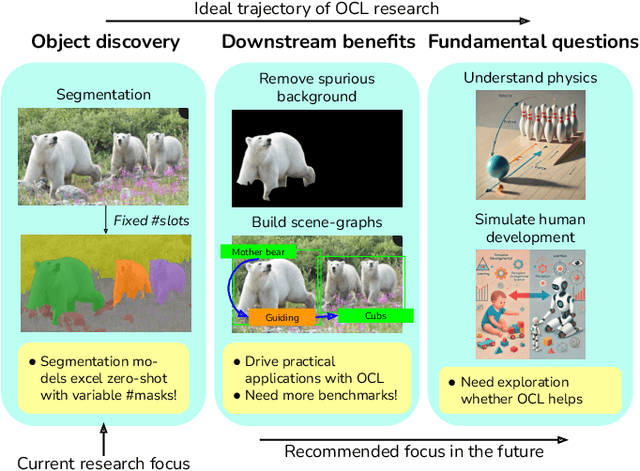

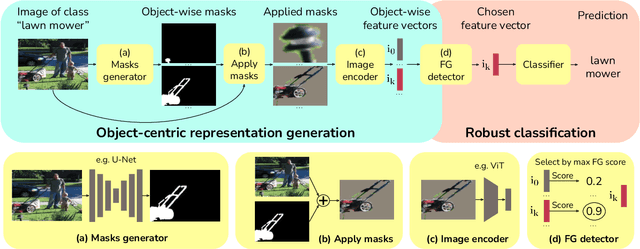
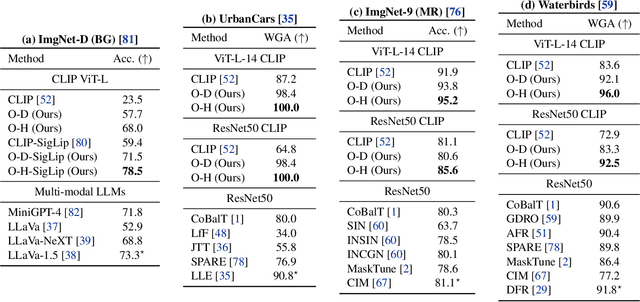
Abstract:Object-centric learning (OCL) seeks to learn representations that only encode an object, isolated from other objects or background cues in a scene. This approach underpins various aims, including out-of-distribution (OOD) generalization, sample-efficient composition, and modeling of structured environments. Most research has focused on developing unsupervised mechanisms that separate objects into discrete slots in the representation space, evaluated using unsupervised object discovery. However, with recent sample-efficient segmentation models, we can separate objects in the pixel space and encode them independently. This achieves remarkable zero-shot performance on OOD object discovery benchmarks, is scalable to foundation models, and can handle a variable number of slots out-of-the-box. Hence, the goal of OCL methods to obtain object-centric representations has been largely achieved. Despite this progress, a key question remains: How does the ability to separate objects within a scene contribute to broader OCL objectives, such as OOD generalization? We address this by investigating the OOD generalization challenge caused by spurious background cues through the lens of OCL. We propose a novel, training-free probe called $\textbf{Object-Centric Classification with Applied Masks (OCCAM)}$, demonstrating that segmentation-based encoding of individual objects significantly outperforms slot-based OCL methods. However, challenges in real-world applications remain. We provide the toolbox for the OCL community to use scalable object-centric representations, and focus on practical applications and fundamental questions, such as understanding object perception in human cognition. Our code is available $\href{https://github.com/AlexanderRubinstein/OCCAM}{here}$.
A Sober Look at Progress in Language Model Reasoning: Pitfalls and Paths to Reproducibility
Apr 09, 2025Abstract:Reasoning has emerged as the next major frontier for language models (LMs), with rapid advances from both academic and industrial labs. However, this progress often outpaces methodological rigor, with many evaluations relying on benchmarking practices that lack transparency, robustness, or statistical grounding. In this work, we conduct a comprehensive empirical study and find that current mathematical reasoning benchmarks are highly sensitive to subtle implementation choices - including decoding parameters, random seeds, prompt formatting, and even hardware and software-framework configurations. Performance gains reported in recent studies frequently hinge on unclear comparisons or unreported sources of variance. To address these issues, we propose a standardized evaluation framework with clearly defined best practices and reporting standards. Using this framework, we reassess recent methods and find that reinforcement learning (RL) approaches yield only modest improvements - far below prior claims - and are prone to overfitting, especially on small-scale benchmarks like AIME24. In contrast, supervised finetuning (SFT) methods show consistently stronger generalization. To foster reproducibility, we release all code, prompts, and model outputs, for reasoning benchmarks, establishing more rigorous foundations for future work.
Understanding the Limits of Lifelong Knowledge Editing in LLMs
Mar 07, 2025Abstract:Keeping large language models factually up-to-date is crucial for deployment, yet costly retraining remains a challenge. Knowledge editing offers a promising alternative, but methods are only tested on small-scale or synthetic edit benchmarks. In this work, we aim to bridge research into lifelong knowledge editing to real-world edits at practically relevant scale. We first introduce WikiBigEdit; a large-scale benchmark of real-world Wikidata edits, built to automatically extend lifelong for future-proof benchmarking. In its first instance, it includes over 500K question-answer pairs for knowledge editing alongside a comprehensive evaluation pipeline. Finally, we use WikiBigEdit to study existing knowledge editing techniques' ability to incorporate large volumes of real-world facts and contrast their capabilities to generic modification techniques such as retrieval augmentation and continual finetuning to acquire a complete picture of the practical extent of current lifelong knowledge editing.
Can Language Models Falsify? Evaluating Algorithmic Reasoning with Counterexample Creation
Feb 26, 2025Abstract:There is growing excitement about the potential of Language Models (LMs) to accelerate scientific discovery. Falsifying hypotheses is key to scientific progress, as it allows claims to be iteratively refined over time. This process requires significant researcher effort, reasoning, and ingenuity. Yet current benchmarks for LMs predominantly assess their ability to generate solutions rather than challenge them. We advocate for developing benchmarks that evaluate this inverse capability - creating counterexamples for subtly incorrect solutions. To demonstrate this approach, we start with the domain of algorithmic problem solving, where counterexamples can be evaluated automatically using code execution. Specifically, we introduce REFUTE, a dynamically updating benchmark that includes recent problems and incorrect submissions from programming competitions, where human experts successfully identified counterexamples. Our analysis finds that the best reasoning agents, even OpenAI o3-mini (high) with code execution feedback, can create counterexamples for only <9% of incorrect solutions in REFUTE, even though ratings indicate its ability to solve up to 48% of these problems from scratch. We hope our work spurs progress in evaluating and enhancing LMs' ability to falsify incorrect solutions - a capability that is crucial for both accelerating research and making models self-improve through reliable reflective reasoning.
Project Alexandria: Towards Freeing Scientific Knowledge from Copyright Burdens via LLMs
Feb 26, 2025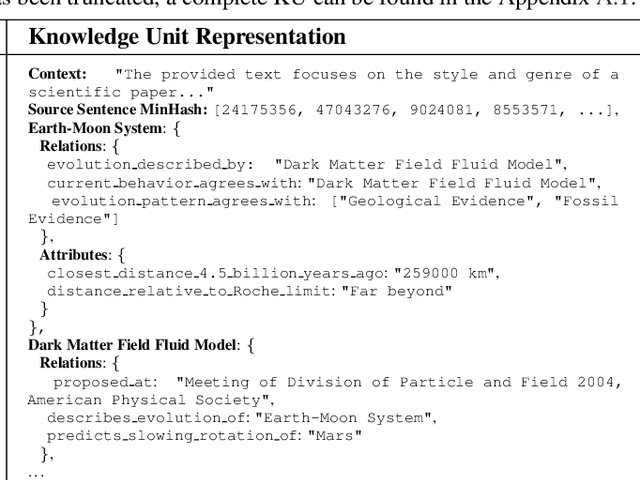
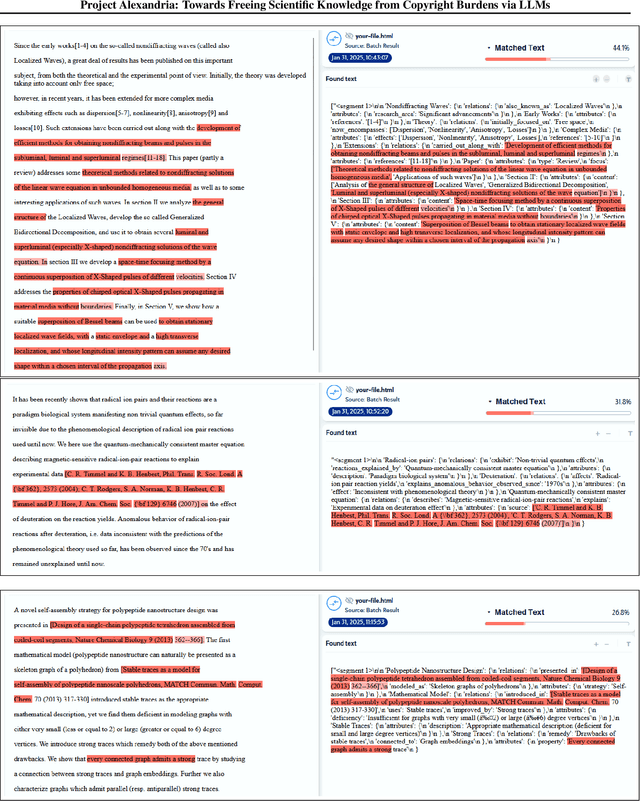

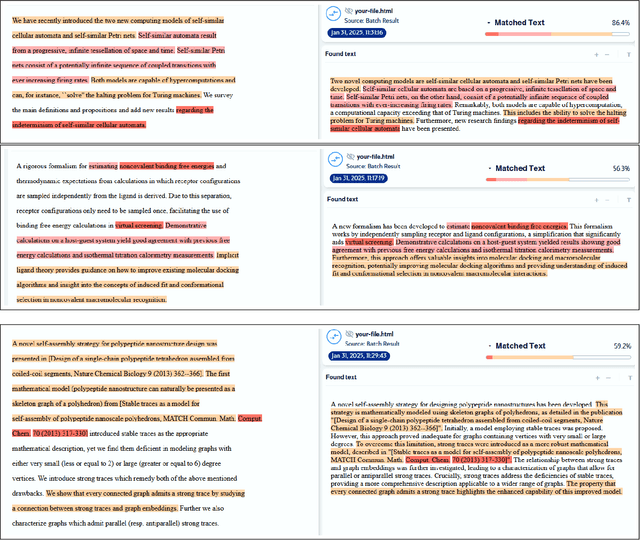
Abstract:Paywalls, licenses and copyright rules often restrict the broad dissemination and reuse of scientific knowledge. We take the position that it is both legally and technically feasible to extract the scientific knowledge in scholarly texts. Current methods, like text embeddings, fail to reliably preserve factual content, and simple paraphrasing may not be legally sound. We urge the community to adopt a new idea: convert scholarly documents into Knowledge Units using LLMs. These units use structured data capturing entities, attributes and relationships without stylistic content. We provide evidence that Knowledge Units: (1) form a legally defensible framework for sharing knowledge from copyrighted research texts, based on legal analyses of German copyright law and U.S. Fair Use doctrine, and (2) preserve most (~95%) factual knowledge from original text, measured by MCQ performance on facts from the original copyrighted text across four research domains. Freeing scientific knowledge from copyright promises transformative benefits for scientific research and education by allowing language models to reuse important facts from copyrighted text. To support this, we share open-source tools for converting research documents into Knowledge Units. Overall, our work posits the feasibility of democratizing access to scientific knowledge while respecting copyright.
 Add to Chrome
Add to Chrome Add to Firefox
Add to Firefox Add to Edge
Add to Edge